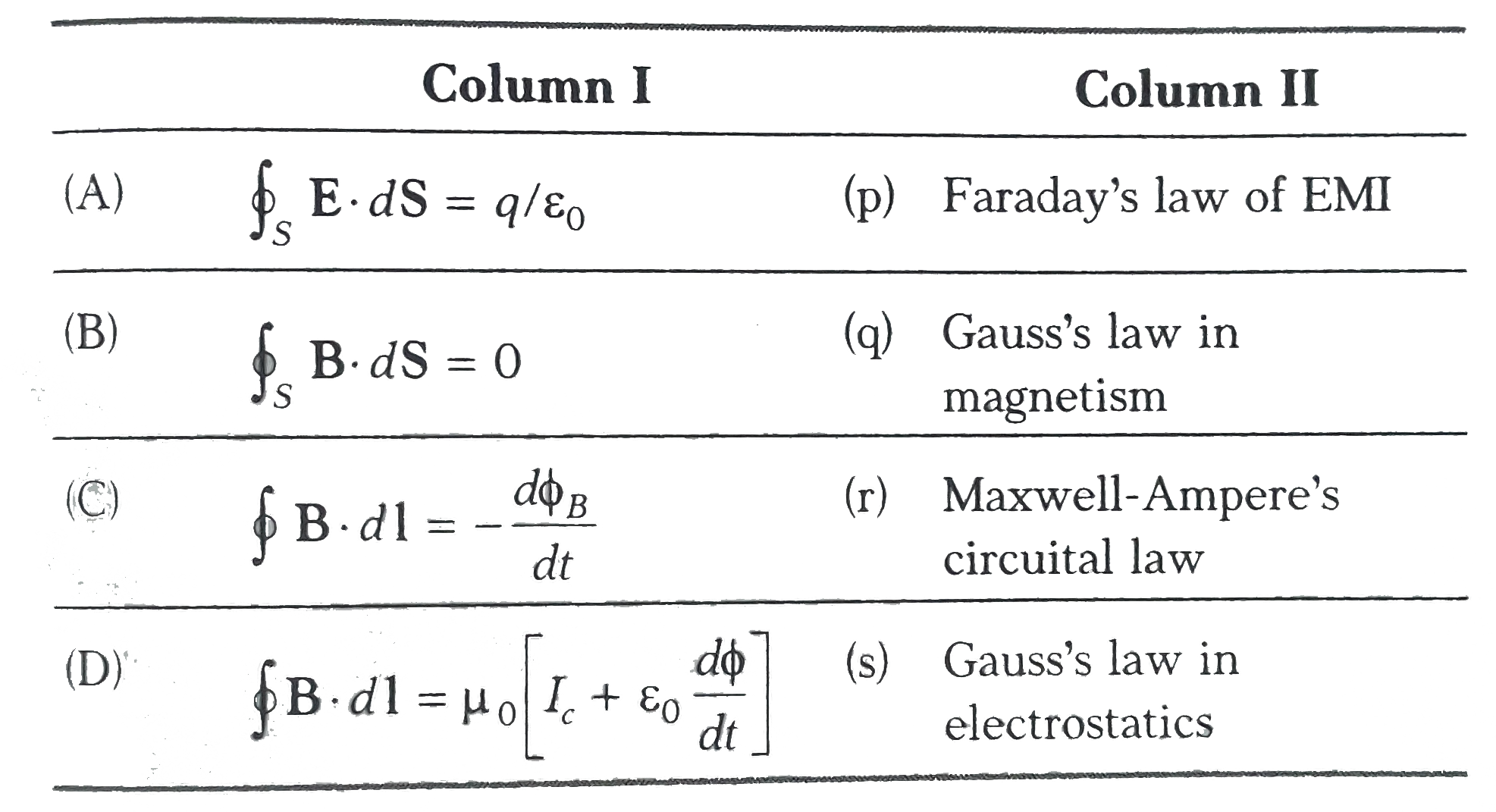The electric field associated with an electromagnetic wave in vacuum is given by →E=40cos(kz−6×108t)ˆi,
where E, z and t are in volt per meter, meter and second respectively. The value of wave vector k is
2m−1
0.5m−1
6m−1
3m−1
The correct Answer is:A
To find the value of the wave vector k from the given electric field expression →E=40cos(kz−6×108t)^i, we can follow these steps:
Step 1: Identify the angular frequency ω
From the expression →E=40cos(kz−6×108t)^i, we can see that the term associated with time t is −6×108t. This term represents the angular frequency ω.
ω=6×108rad/s
Step 2: Use the relationship between wave speed, angular frequency, and wave vector
The relationship between wave speed v, angular frequency ω, and wave vector k is given by:
v=ωk
Step 3: Substitute the speed of light for v
In a vacuum, the speed of electromagnetic waves is equal to the speed of light c, which is approximately:
c=3×108m/s
Step 4: Rearrange the equation to solve for k
We can rearrange the equation to solve for k:
k=ωv
Substituting the values we have:
k=6×1083×108
Step 5: Calculate k
Now, perform the calculation:
k=2m−1
Final Answer
Thus, the value of the wave vector k is:
2m−1
---
From the expression →E=40cos(kz−6×108t)^i, we can see that the term associated with time t is −6×108t. This term represents the angular frequency ω.
The relationship between wave speed v, angular frequency ω, and wave vector k is given by:
In a vacuum, the speed of electromagnetic waves is equal to the speed of light c, which is approximately:
We can rearrange the equation to solve for k:
Now, perform the calculation:
Thus, the value of the wave vector k is:
Topper's Solved these Questions
- ELECTROMAGNETIC WAVESBOOK - DC PANDEY ENGLISHCHAPTER - ELECTROMAGNETIC WAVESEXERCISE - Match the columns
2 Videos
- ELECTROMAGNETIC INDUCTIONBOOK - DC PANDEY ENGLISHCHAPTER - ELECTROMAGNETIC INDUCTIONEXERCISE - Medical entrances gallery
25 Videos
- ELECTROSTATIC POTENTIAL AND CAPACITORSBOOK - DC PANDEY ENGLISHCHAPTER - ELECTROSTATIC POTENTIAL AND CAPACITORSEXERCISE - (C) Chapter exercises
50 Videos
Similar Questions
Math column I with Column II and select the correct options from the choices given below the columns.

View SolutionA long solenoid has 1000 turns. When a current of 4A flows through it, the magnetic flux linked with each turn of the solenoid is 4×10−3Wb. The self-inductance of the solenoid is
View SolutionA capacitor of 2μF is charged as shown in the figure. When the switch S is turned to position 2, the percentage of its stored energy dissipated is

View SolutionThe electric field associted with an electromagnetic wave in vacuum is given by vecE=hati 40 cos(kz=6xx10^(8)t) , when E , z and t are in volt//m, metre and second respectively
View SolutionThe electric field associated with an e.m. wave is described by the equation E=E0sin(4π×106x−1.2π×1015t) volt/meter, where x is in merter and t in second. The wavelength of the wave in the wave in the unit of 10−7m is:
View SolutionThe electric field associated with an electromagnetic wave in vacuum is given by vecE=40cos(kz-6xx10^(8)t)hati, where E, z and t are in volt per meter, meter and second respectively. The value of wave vector k is
View Solutionएक विधुत - चुम्बकीय तरंग में विधुत क्षेत्र की तीव्रता 30 वाल्ट/मीटर हैं । चुम्बकीय क्षेत्र की तीव्रता ज्ञात कीजिए । (c=3×108 मीटर/सेकण्ड )
View Solutionविद्युत्-चुंबकीय तरगों की उत्पत्ति कैसे होती है ? साधारण गणना द्वारा दर्शाइए की निर्वात में विद्युत्-चुंबकीय तरगों की चाल 3×108 मीटर/सेकण्ड होती है ।
View SolutionThe electric field associated with an em wave in vacuum is given by →E=40cos(kz−6×108t)ˆi, where E, z and t are in V.m−1. meter and seconds respectively. The value of wave vector k is
View Solutionकल्पना कीजिए कि निर्वात में एक विद्युत चुंबकीय तरंग का विद्युत क्षेत्र →E={(3.1N/C)cos[(1.8 rad/m)y+(5.4×106 rad/s)t]}ˆi है|
(d ) तरंग के चुंबकीय क्षेत्र सदिश का आयाम कितना है?
View Solutionकल्पना कीजिए कि निर्वात में एक विद्युत चुंबकीय तरंग का विद्युत क्षेत्र →E={(3.1N/C)cos[(1.8 rad/m)y+(5.4×106 rad/s)t]}ˆi है|
(e ) तरंग के चुंबकीय क्षेत्र के लिए व्यंजक लिखिए |
View Solutionनिर्वात् में किसी वैद्युत चुम्बकीय तरंग से सम्बद्ध वैद्युत क्षेत्र को E=i40cos(kz–6×108t) द्वारा व्यक्त किया जाता है, जहाँ E,z तथा t क्रमश: वोल्ट/मीटर, मीटर तथा सेकण्ड में हैं। तरंग संख्या k का मान है
View SolutionElectric field in one electromagnetic wave, propagating in vacuum is E=40 cos(kz - 6xx10^(8)t)hat(i) (where all the values are in SI units). Then value of wave vector of this wave is ……. .
View Solutionनिर्वात में विघुतचुम्बकीय तरंग के साथ सम्बन्धित विघुत क्षेत्र को →E=70cos(kz−9×108t)ˆi द्वारा दिया जाता है, जहाँ E, z एवं t क्रमशः वोल्ट प्रति मीटर, मीटर एवं सेकंड में होते है | तरंग सदिश k का मान होगा-
View SolutionThe electric field of a plane electromagnetic wave is given by →E(t)=E0ˆi+ˆj√2cos(ωt+kz). At t = 0, a positively charged particle is at the point (x,y,z)=(0,0,πk). If its instantaneous velocity at t = 0 is v0ˆk, the force acting on it due to the wave is
View Solution
